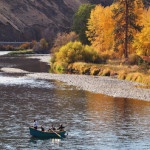We have much more to do and your continued support is needed now more than ever.
Engaging with local communities has big salmon and water conservation payoffs
One of the things that I like about working at the National Wildlife Federation is that when we develop solutions to tough environmental problems, we work hard to engage people who will be directly affected. This approach is not only fair to those affected, it is also likely to provide the most tangible and lasting benefits for wildlife. If local folks are not involved in shaping the policies governing their use of natural resources, they probably will find some way to undermine those policies in the long run.
 NWF’s Yakima River salmon and ecosystem restoration project in Washington state, led by Steve Malloch, is a good example of how this kind of engagement with local communities pays off. As this editorial by the conservative Seattle Times points out, the conservation community has negotiated a very promising deal with farmers and the Native American tribe in the Yakima basin. Declining snow pack and other impacts of climate change on local hydrology poses huge threats to the livelihoods of farmers as well as to the future of the salmon that the Yakima Nation tribe depends upon. These threats caused everyone – the farmers, the Yakama Nation, conservationists and government at all levels – to take a new look at how to manage the water.
NWF’s Yakima River salmon and ecosystem restoration project in Washington state, led by Steve Malloch, is a good example of how this kind of engagement with local communities pays off. As this editorial by the conservative Seattle Times points out, the conservation community has negotiated a very promising deal with farmers and the Native American tribe in the Yakima basin. Declining snow pack and other impacts of climate change on local hydrology poses huge threats to the livelihoods of farmers as well as to the future of the salmon that the Yakima Nation tribe depends upon. These threats caused everyone – the farmers, the Yakama Nation, conservationists and government at all levels – to take a new look at how to manage the water.

This formula for achieving broad support of a new water management policy may not work everywhere, but in this basin, it is the only way to create a more resilient ecosystem and economy – good for fish, farmers, forests and families.





















